Leslie Lerner
The Man with the Wooden Arm: The Imagined City
March 19 – May 15, 1999
USF Contemporary Art Museum
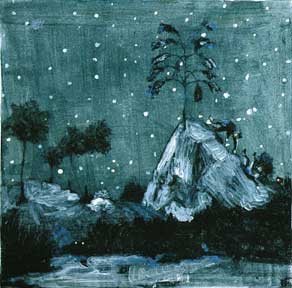
Leslie Lerner, Crime.
Leslie Lerner is an artist who blends the symbolic, the imaginary and the real in equal parts in his work. He produces sumptuously novelistic, luminously detailed paintings that are unparalleled in the contemporary art world. Ostensibly recording the journeys of the mysterious renegade The Man with the Wooden Arm, Lerner's alter ego, these "Grand Tour" travel paintings are really about interior states of mind.
In his 17th century adventures throughout Europe and the Orient, The Man with the Wooden Arm discovers a contemporary reality: you can never go home again. The second best thing is to uncover the real "you" and find a true haven within yourself.
Leslie Lerner is originally from San Francisco and has worked in Sarasota, Florida for 6 years. He is the recipient of numerous awards including the Western States Arts Federation/NEA Fellowship, the Pollock/Krasner Fellowship, the Eureka Fellowship and the Florida Individual Artist Grant. He is represented by Littlejohn Contemporary in New York and the Mira Mar Gallery in Sarasota.
Leslie Lerner has created several works with Graphicstudio. View her artist page here.
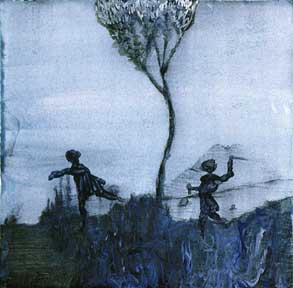
Leslie Lerner, Crime.
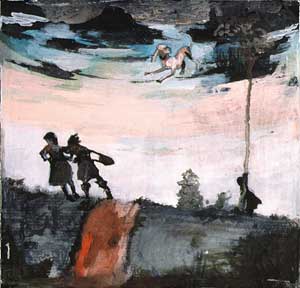
Leslie Lerner, Crime.
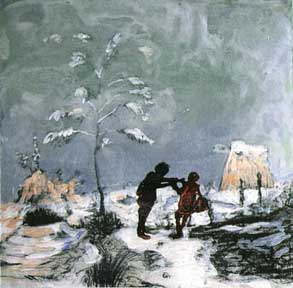
Leslie Lerner, Crime.
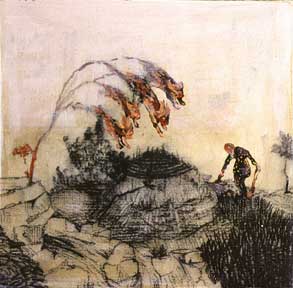
Leslie Lerner, Nature.
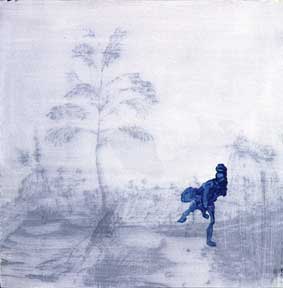
Leslie Lerner, Nature.
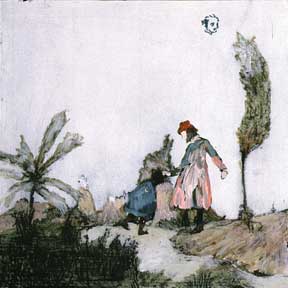
Leslie Lerner, Nature.
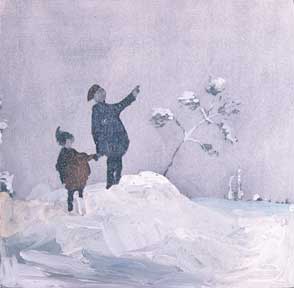
Leslie Lerner, Nature.
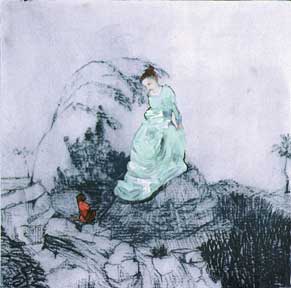
Leslie Lerner, Romance.
NARRATIVE BY LESLIE LERNER
1670
When he was young The Man With The Wooden Arm had fled Delft. He traveled south in mortal pain after losing an arm to the great arsenal explosion. A piece of timber had cut through the Dutch night sky tearing away flesh and bone. He woke wounded, covered with dust and pottery shards. No one knew what caused the fiery detonation but it was certain some would be suspected and accused of sabotage.
A Catholic in the midst of a civil and religious war his parents felt they were left little choice. The young man's family met hastily and it was agreed he should leave Delft at once. He would go to Venice, be sheltered by friends in what they imagined would be a "good" city where he could learn the ways of commerce.
The Man With The Wooden Arm was never clear about things after that accident. He couldn't remember where he was or what he was doing the night the timber missile found him, why his family had bundled him up and hustled him away.
He traveled awake but awoke at times to find himself being spirited along. Places and persons he met were jumbled and tossed like puzzle pieces that somehow fit and refit in new combinations making landscape and time go back and forth like a river that would turn on itself, straighten out and turn again. His core was fear, the certainty that he would be recognized, found out! Yet he never was certain what he had done, it was enough just to get through each day, pass a new place, pretend he knew who he was and go on.
The hole where his arm had been closed but the hole never left his side. To fill it he had a new arm made. The wooden arm was carefully constructed of the lightest ash, a master furniture maker had spun it on a lathe and hinged it at elbow and wrist with catgut and ball joints to swivel and bend with no sound, no catch, no pain. But when he wore it, it never felt natural...like the hole. So he stored it away and on special occasions or for a new acquaintance he would open the arm's traveling case and hold it in his one hand, rest it in his lap and examine with care it's craft and look. Soon all along the journey's way he became known as The Man With The Wooden Arm, but to himself he was always a man with a hole.
There was no anxious host waiting, no happy expectation. No messengers were sent out to greet or guide the man with the hole. As news spread in Venice of the strange, bemused Dutchman quite the opposite affect occurred. Soon the plan his parent's had counted on fell away, no one mentioned the Dutchman's name. As by not saying it, he might never arrive. And as our traveler had also forgotten his names, both given and Christian, he soon disappeared to the great relief of his rescuers and the everlasting sorrow of his family.
The Man With The Wooden Arm spent his days and dwindling purse at taverns and wayside inns, town squares and bordellos. Sometimes displaying his arm for a coin or two. It was not time he regretted. He thought of it as a grand school, a mighty procession of lessons and tests. And quite a curriculum too, his teachers and fellows often taught by example and invited participation. How fortunate he was that his hole was still able to speak with a well spoken tongue.
He could ably use his gift to coordinate a robbery, mediate a troubled marriage, identify a dozen species of birds or negotiate the price of a rare gem. His school masters never failed to let him perform, to impress and succeed. His education progressed favorably while his feet doubled back but then moved a little further on towards what he imagined was the great green sea soaked city.
Venice
The man with the hole found himself ironically in a city of whores. And it was precisely these ladies that completed his course of study. It was by watching the negotiations, the bidding, the sale and the possession that he was able to grasp the small but most crucial aspects of business. But in his odd way he could only make sense of it architecturally. Each lesson learned was tied in his thoughts to a specific building. To use what he knew he had to attach the idea to a chapel, grain house, tower or tenement. He entered upon his new life as a fixer, a commission man and finally wore the cloak and hat of a merchant based on his study of the city itself!
In this floating world he met Cardinals and cooks, gamblers, book printers, soldiers and sea captains and slept every fortnight with a countess in a sewer. And it was this liaison that opened the door to India.
Leslie Lerner © 1997